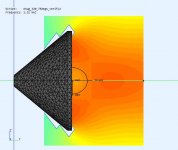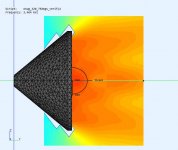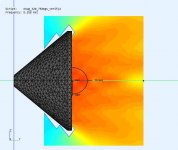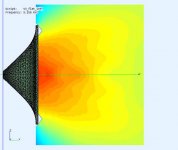we are spinning in a circle...
camplo decide not to use such a horn:



and I fully agree with him.
Beaming is kind of natural. Nearly all natural sound sources beam. Even we if we speak to another person - we beam. For home use with a generally very restricted listening area vertically vise and only slightly changing in the horizontal plane, 45 degrees or even less is perfectly fine.
Next argument to discuss: "if you can't see the throat- they "beam"."
Look at the WE KS10024 horn. You cannot see the throat and it does not beam much horizontally. Also the TH4001, I can hardly see the throat and does not beam.
CD properties is a completely overrated criterion and has nothing in common with a guarantee of good sound.
camplo decide not to use such a horn:



and I fully agree with him.
Beaming is kind of natural. Nearly all natural sound sources beam. Even we if we speak to another person - we beam. For home use with a generally very restricted listening area vertically vise and only slightly changing in the horizontal plane, 45 degrees or even less is perfectly fine.
Next argument to discuss: "if you can't see the throat- they "beam"."
Look at the WE KS10024 horn. You cannot see the throat and it does not beam much horizontally. Also the TH4001, I can hardly see the throat and does not beam.
CD properties is a completely overrated criterion and has nothing in common with a guarantee of good sound.
That seems reasonable as no one would want to use such a horn.camplo decide not to use such a horn: ...
Sure, because in a properly executed OS waveguide you should take only a small fraction of the actual OS profile and tranform the rest of it very gradually towards the mouth to achieve both smooth response and constant directivity. What you show is a typical behaviour of an abruptly terminated axisymmetric waveguide. You really should do better.
Last edited:
From my experience I could not use JMLC 200Hz full range but JMLC 350Hz was ok. Quad ESL57 beam like hell but I still love its tonal balance. I think exponential horn will appeal many. Question is which is best compromise. One or two horns and sizes.
CD properties is a completely overrated criterion and has nothing in common with a guarantee of good sound.
Well that is one opinion - against several experts here as well as the experts at Harman, etc. It's certainly a minority view.
Sure, because in a properly executed OS waveguide you should take only a small fraction of the actual OS profile and tranform the rest of it very gradually towards the mouth to achieve both smooth response and constant directivity. What you show is a typical behaviour of an abruptly terminated axisymmetric waveguide. You really should do better.
Your right, the OSWG in the previous post is a "pure OS" and it has an abrupt termination. It also is a 4Pi space sim (diffraction allowed at mouth).
To compare fairly, here is a design from your calculator (it's the example I think). The inner horn is exact from calculator, an outer horn was added to support 4Pi space simulation. I also removed the "dome" extended subdomain interface and replaced it with a flat interface so the horn physical mouth apex and subdomain are now consistent. No question its better than pure OS but it still has some of the OS artifacts.
Attachments
Well that is one opinion - against several experts here as well as the experts at Harman, etc. It's certainly a minority view.
Just to clarify.
Everything I've read from the Toole / Olive experiments on speakers and user preferences indicated a "smooth" DI curve. The reasoning was to get consistent timbre from the reflections. I don't recall "constant" being a requirement, even though constant could also be smooth.
Yeah, of a badly executed one.
This statement is pure polemic, because it is assumed here that the ABEC project itself was badly created. Certainly, you can refine the mesh resolution but the overall result will not look much better for the original OSWG.
In Camplo's shoes, I would opt for a horn that incorporates the best of both worlds.
A horn that provides decent loading, as well as reasonable coverage.
Once the lower usable limit is raised from 200-300Hz to 400-500Hz this should be possible.
I bet the Axi2050 would even work with a conical horn from about 400Hz.
A horn that provides decent loading, as well as reasonable coverage.
Once the lower usable limit is raised from 200-300Hz to 400-500Hz this should be possible.
I bet the Axi2050 would even work with a conical horn from about 400Hz.
My objection was to the waveguide presented (the abruptly teminated one), nothing to do with the simulation. DonVK already admitted it so that should be clear now.This statement is pure polemic, because it is assumed here that the ABEC project itself was badly created. Certainly, you can refine the mesh resolution but the overall result will not look much better for the original OSWG.
There is nothing that would prevent an OSWG from having a smooth frequency response, it's a matter of proper termination. I don't care about the personal choices of horns but please, when you do comparisons, ensure they are fair.
Last edited:
I don't see where the "unfair" part is.
The first sim was for a pure OSWG, to see how it behaved. That is fair because termination is not defined by OSWG profile.
The second sim was for your "variant" of the OSWG. You modified it to improve it.
Is the variant still OSWG ? do you believe it represents all OSWG ?
The first sim was for a pure OSWG, to see how it behaved. That is fair because termination is not defined by OSWG profile.
The second sim was for your "variant" of the OSWG. You modified it to improve it.
Is the variant still OSWG ? do you believe it represents all OSWG ?
Sure, because in a properly executed OS waveguide you should take only a small fraction of the actual OS profile and tranform the rest of it very gradually towards the mouth to achieve both smooth response and constant directivity. What you show is a typical behaviour of an abruptly terminated axisymmetric waveguide. You really should do better.
No actual OS waveguide was ever a pure OSWG. No one would ever do that because it would perform so badly. That's what I'm talking about and that was the unfair part - to show the worst case as the reason why it should be refused. The OS segment is important near the throat where it makes for a nice directivity up to very high frequencies - that's the reason why it is still called OSWG, I guess. The rest is more about the termination and how to do it gradually than anything else.
Last edited:
I also cannot recognize any unfair part - except your own comment.
It is a valid approach to follow the original publications / formulas and simulate the horn in 4pi space. Btw, the example picture show a very slight termination. One could add a tiny roll-over but this would not change results much.
Btw, in this incarnation I also cannot see a smooth termination o the horn:
Gedlee Abbey-old build new thread | AV NIRVANA
Your problem may be that you assumed a connection to your own work but there was none as your horns are no OSWG anymore - except the throat region.
It is a valid approach to follow the original publications / formulas and simulate the horn in 4pi space. Btw, the example picture show a very slight termination. One could add a tiny roll-over but this would not change results much.
Btw, in this incarnation I also cannot see a smooth termination o the horn:
Gedlee Abbey-old build new thread | AV NIRVANA
Your problem may be that you assumed a connection to your own work but there was none as your horns are no OSWG anymore - except the throat region.
The original objection here was that the horn presented is not CD. In your reply you implied that a constant directivity waveguide would (necessarily) suffer from these problems. That's simply not true. The actual choice here is between a smooth beaming horn or a smooth constant directivity waveguide (call it OS or not). Pick your poison 😛
Last edited:
In Camplo's shoes, I would opt for a horn that incorporates the best of both worlds.
A horn that provides decent loading, as well as reasonable coverage.
Once the lower usable limit is raised from 200-300Hz to 400-500Hz this should be possible.
I bet the Axi2050 would even work with a conical horn from about 400Hz.
Klipsch K402 like 😀
Well that is one opinion - against several experts here as well as the experts at Harman, etc. It's certainly a minority view.
Just to clarify.
Everything I've read from the Toole / Olive experiments on speakers and user preferences indicated a "smooth" DI curve. The reasoning was to get consistent timbre from the reflections. I don't recall "constant" being a requirement, even though constant could also be smooth.
I need to correct myself on this.
I rewatched a 2015 lecture by Toole YouTube and he does say "smooth and relatively constant DI" (@57min). The next 10 min are critiques of speakers that have rising DI curves but he's only critical of the non-smooth ones.
.
- Home
- Loudspeakers
- Multi-Way
- Is it possible to cover the whole spectrum, high SPL, low distortion with a 2-way?
